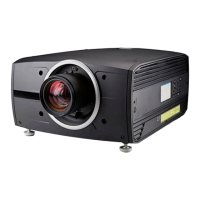601–426 /17 F70 Series144
9.1 Profiles introduction
About Profiles
The profile function makes it possible to store different profiles / projector setups for different use cases, and
quickly recall them when needed. This means that it is not necessary to enter a lot of different menus to adjust
the projector setup for specific recurring use cases. Due to the limited nature of this function and to avoid
terminology confusion with more complex macro’s, these are not called “macro’s”, but “profiles”.
A few examples of different user cases are:
• Building temporary gaming setups in bright auditorium-level environment, versus a darker “gaming room”
or “cave”.
• Playing content from an old DVD versus playing the latest release from an HDR-coded Blu-Ray.
• A rental projector that can be rented out for business presentations, concerts and other events that have
different but recurring forms of content.
Image 9–1
Available profile settings
The following projector settings can be saved to a projector profile:
Profile domain
name
Settings saved
Illumination
• Illumination power of light source
• Light sensor enabled / disabled
• Light sensor set point
Source Active source selection & EDID
Image
• Contrast
• Brightness
• Saturation
• Sharpness
• Gamma
• Used gamma type
• Digital zoom (width / height / factor + enabled/disabled)
• Digital shift (x / y + enabled / disabled)
• Output resolution
Display (3D
settings)
• 3D Display mode used
• Swap eyes on / off
• Swap frame pair on / off
• Dark time and sync delay values
Realcolor
TM
• Brilliant Color mode (if available)
• P7 desired values
• P7 measured values
GUI – Profiles

